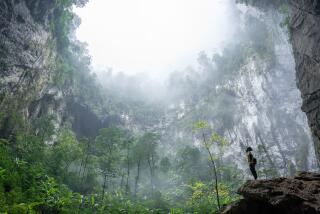‘Bat’ Wings : Pioneer Built Planes in Chinese Cave
- Share via
He smiles when he hears how the B-2 Stealth bomber is on thecutting edge of aeronautical technology.
That is because the bomber that Tung-Hua Lin stealthily set out to build nearly 50 years ago was on the cutting edge, too.
Like the B-2, Lin’s plane was constructed from non-metallic material on a secret assembly line. And like the B-2, it surprised cynics by performing better than expected once it took to the air.
The fact that Lin’s airplane flew at all surprised people in 1944.
He designed the 3 1/2-ton craft from scratch without blueprints. Then he built it out of wood in a cave next to a Chinese rice field.
His twin-engine C-1010 was the first plane ever designed, built and flown in China. It was the first plane anywhere to be built in a cave.
These days, Lin is a civil engineering professor at UCLA whose study of earthquake-stress in construction materials led last year to his election to the prestigious National Academy of Engineering. Few of his students realize that the amiable, animated 79-year-old is also an aircraft pioneer.
In those days, Lin was China’s one-man aircraft industry.
Lin was teaching at a Chinese university at the outbreak of World War II. Because he had studied engineering in the United States and worked briefly at several American airplane factories, military authorities drafted him to restore two Italian-made aircraft that had been left in China by Benito Mussolini in the late 1930s.
As fighting with Japan continued, Lin scouted the interior of China for a safe place to work on the planes. He settled on a cave used by rice farmers as a Buddhist shrine.
When the Italian planes proved too rusty to be salvaged, officials asked Lin to make copies of a Russian pursuit fighter they had acquired. Workers at the cave produced about 20 of them, but Tokyo’s newly designed Zero fighters quickly shot them all down.
Lin decided to build a bomber from scratch in the humid, dripping cave, located about 150 miles east of the city of Chongqing, known then to Westerners as Chungking.
“We didn’t have electricity,” Lin said. “We had a small diesel engine to generate power. But we soon used up the oil, so we burned vegetable oil in it.”
There was no gasoline, either. So Lin converted the trucks that shuttled supplies to the cave to run on alcohol.
“When we sent them to Chungking, the drivers would stop in at bars along the way. Not to drink themselves, but for the engines. We had to put a Chinese herb additive in the truck tanks to keep people from trying to drink our fuel.”
Before he was finished, Lin changed the bomber into a transport. That way, he reasoned, advancing Japanese technology would not wipe him out. “And a transport wouldn’t be obsolete after the war. There’s always a need to transport people and cargo,” he said.
The wooden bomber-turned-transport was finished in mid-1944. There was no wind tunnel or other test equipment at the cave, so Lin had the C-1010’s wings unbolted and the pieces carried to a nearby airstrip for a do-or-die test flight.
Shaky from malaria contracted in the cave, Lin made last-minute adjustments to a sticky landing gear. Then, to calm the nervous test pilot, Lin climbed aboard for the maiden flight.
Once aloft, an elated Lin ordered the pilot to fly over the mouth of the cave so his 300 workers could see their handiwork.
“I told him to fly lower, so it would look faster,” Lin said. “The workers felt really great. They thought the plane was very good because it was so fast.”
Yuk Yung, a space science professor at Caltech who is writing Lin’s biography, said present-day aeronautical designers are surprised to hear that an aircraft as sophisticated as the C-1010 was built from scratch under such makeshift conditions.
Two other C-1010s were built in the cave. When the war ended in 1945, Chinese officials turned their attention to jets and sent Lin to the United States and then Great Britain to negotiate production contracts.
Lin moved permanently to the United States in 1949 when the communists drove Chinese nationalists to Taiwan. He joined the UCLA faculty in 1955, where he is a professor emeritus who teaches a graduate class in the “inelastic effects” of materials’ structural strength.
Students say the cave episode shows a different kind of strength.
“He’s pretty gutsy to do what he did,” said Ed Rayas, 22, a civil engineering senior who became interested in Lin’s work after seeing a snapshot of the cave. “It’s fantastic. My friends involved in aerospace and aeronautics want him to give a presentation to them.”
Stanley Dong, chairman of the UCLA civil engineering department, said people are surprised by the difficulties that pioneers such as Lin overcame.
“The Wright Brothers didn’t have the Lockheed factory’s Skunk Works,” Dong said.
Neither did Lin. But his spunk worked.
More to Read
Sign up for Essential California
The most important California stories and recommendations in your inbox every morning.
You may occasionally receive promotional content from the Los Angeles Times.














